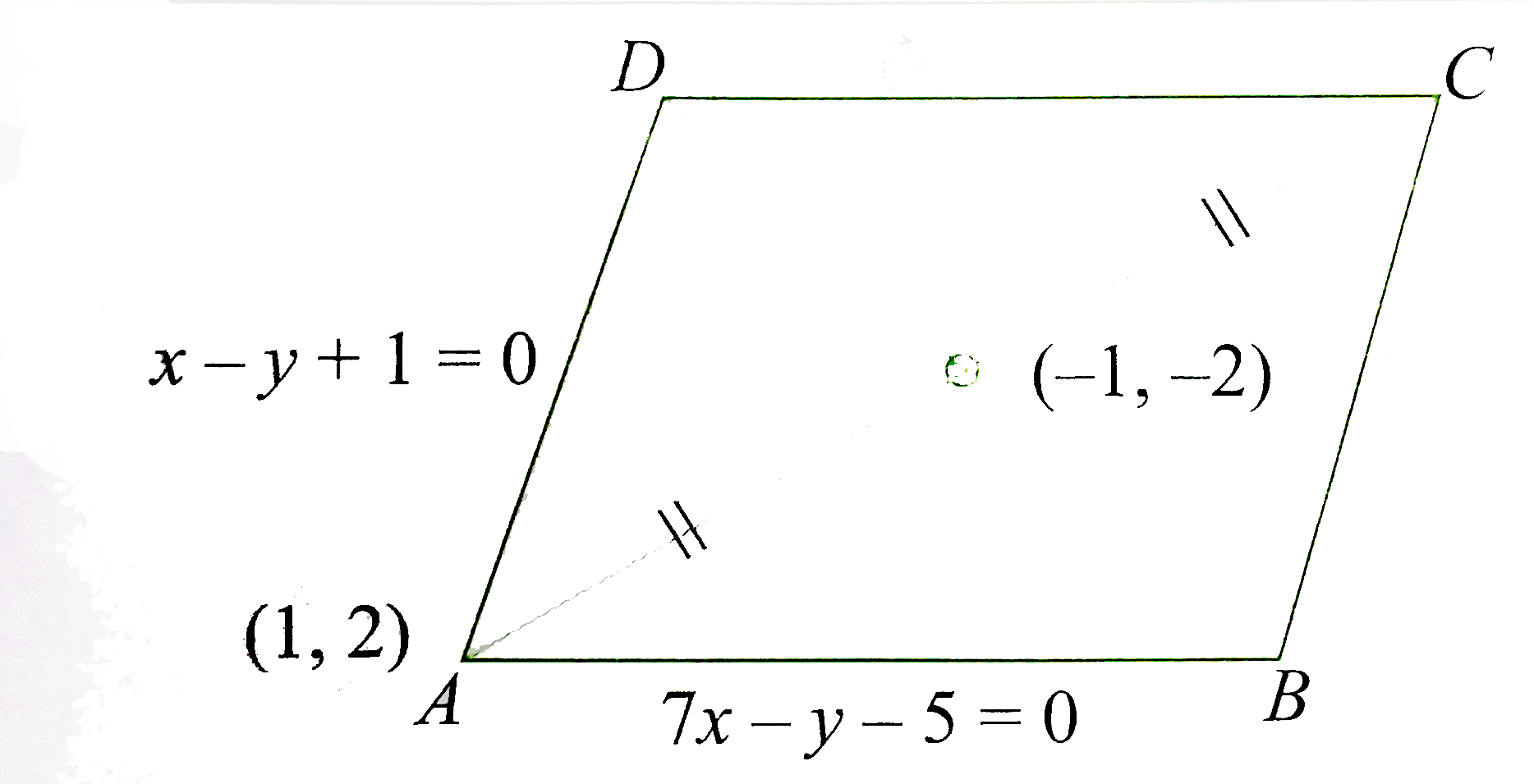Two sides of a rhombus are along the lines,x−y+1=0 and 7x−y−5=0 . If its diagonals intersect at (−1,−2) , then which one of the following is a vertex of this rhombus ? (1) (−3,−9) (2) (−3,−8) (3) (13,−83) (4) (−103,−73)Solution in Bengali
(-3, -8)
(13,−83)
((−103,−73)
(-3, -9)
The correct Answer is:B

On solving equation of AB and AD, vertex A(1, 2)
∵(−1,−2) is midpoint of AC, vertex C is (−3,−6).
Line BC is parallel to AD passing through point C, hence its equation is x-y-3 =0
Line DC is parallel to AB passing through ponit C, hence its equation is 7x-y+15=0
Hence other vertices are
B(13,−83) and D(−73,−43)
Topper's Solved these Questions
- STRAIGHT LINESBOOK - CENGAGE PUBLICATIONCHAPTER - STRAIGHT LINESEXERCISE - ARCHIVES (JEE ADVANCED)
3 Videos
- STRAIGHT LINESBOOK - CENGAGE PUBLICATIONCHAPTER - STRAIGHT LINESEXERCISE - ARCHIVES (NUMERICAL VALUE TYPE)
1 Videos
- STRAIGHT LINESBOOK - CENGAGE PUBLICATIONCHAPTER - STRAIGHT LINESEXERCISE - EXERCISE (NUMERICAL VALUE TYPE)
13 Videos
- STRAIGHT LINEBOOK - CENGAGE PUBLICATIONCHAPTER - STRAIGHT LINEEXERCISE - Multiple Correct Answers Type
8 Videos
- THEORY OF EQUATIONSBOOK - CENGAGE PUBLICATIONCHAPTER - THEORY OF EQUATIONSEXERCISE - JEE ADVANCED (Numerical Value Type )
1 Videos
Similar Questions
The locus of the orthocentre of the triangle formed by the lines (1+p)x−py+p(1+p)=0,(1+q)x−qy+q(1+q)=0 and y = 0, where p≠⋅q, is (A) a hyperbola (B) a parabola (C) an ellipse (D) a straight line
View SolutionFor a point P in the plane, let d1(P)andd2(P) be the distances of the point P from the lines x−y=0andx+y=0 respectively. The area of the region R consisting of all points P lying in the first quadrant of the plane and satisfying 2≤d1(P)+d2(P)≤4, is
View SolutionFind the number of permutations of the set {1,2,3,4} in which no two adjacent positions are filled by consecutive integers ( increasing orders).
View SolutionThe point P(α,α+1) will lie inside the triangle whose vertices are A(0,3),B(−2,0) and C(6,1) if
View SolutionThe number of distinct real roots of x4−4x3+12x2+x−1=0is_____.
View SolutionTwo sides of a rhombus are along the lines, x-y+1=0 and 7x-y-5=0. If its diagnols intersect at (-1,-2), then which one of the following is a vertex of a rhombus? a. (−3,−9) b. (−3,−8) c. (13,−83) d. (−103,−73)
View SolutionTwo sides of a rhombus are along the lines,x−y+1=0 and 7x−y−5=0 . If its diagonals intersect at (−1,−2) , then which one of the following is a vertex of this rhombus ?
View SolutionTwo sides of a rhombus are along the lines x - y + 1 = 0 and 7 x - y - 5 = 0 . If its diagonals intersect at ( - 1, -2) , then which one of the following is a vertex of this rhombus ?
View SolutionTwo sides of a rhombus ABCD are parallel to the lines y = x + 2 and y = 7x + 3. If the diagonals of the rhombus intersect at the point (1, 2) and the vertex A is on the y-axis, find the possible coordinates of A. x – y – 1 = 0 are the equations of two internal bisectors of its angles.
View SolutionThe sides of a rhombus ABCD are parallel to the lines x−y+2=0 and 7x−y+3=0, If the diagonals of the rhombus intersect at P(1,2) and the vertex A (different from the origin) is on the y-axis then the ordinate of A is:
View Solutionयदि एक समचतुर्भुज की दो भुजाएं रेखाओ x−y+1=0 तथा 7x−y−5=0 की दिशा में है तथा इसके विकर्ण बिन्दु (−1,−2) पर प्रतिच्छेद करते हैं, समचतुर्भुज का निम्न में से कौन-से शीर्ष है
View SolutionTwo sides of a rhombus ABCD are parallel to the lines y = x + 2 and y = 7x + 3 If the diagonals of the rhombus intersect at the point (1, 2) and the vertex A is on the y-axis, then vertex A can be
View SolutionTwo sides of a rhombus ABCD are parallel to the lines y = x + 2 and y = 7x + 3 If the diagonals of the rhombus intersect at the point (1, 2) and the vertex A is on the y-axis, then vertex A can be
View SolutionTwo sides of a rhombus are along the lines,x−y+1=0 and 7x−y−5=0 . If its diagonals intersect at (−1,−2) , then which one of the following is a vertex of this rhombus ? (1) (−3,−9) (2) (−3,−8) (3) (13,−83) (4) (−103,−73)
View SolutionTwo sides of a parallelogram are along the lines x + y = 3 and x - y + 3 = 0. If it intersects on its diagonal (2, 4), it has a vertex.
View SolutionIf two sides of a rhombus lines x-y +1 =0 And 7x - y 5=0 Is in the direction of and its diagonal point (-1,-2) But the intersection is karte, which of the following vertices of rhombus is
View Solution
